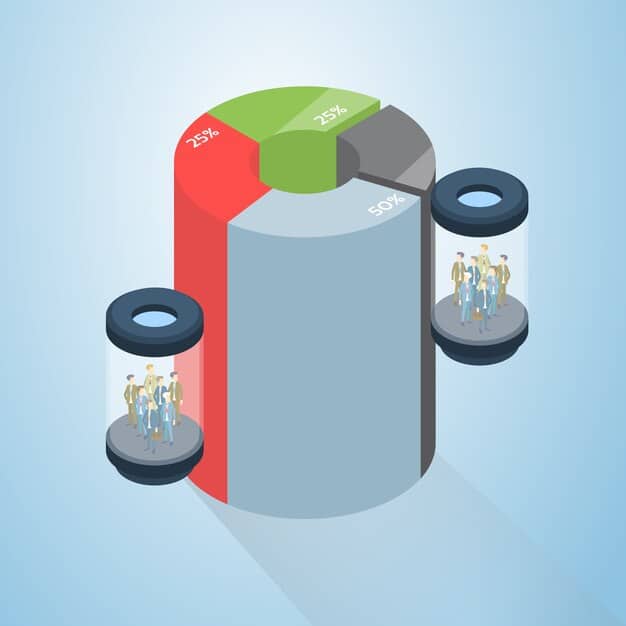How a 2.3% GDP Growth in 2025 Will Shape Your Business Strategy

The projected 2.3% GDP growth in 2025 presents both opportunities and challenges for businesses, requiring a strategic reassessment of investments, market positioning, and operational efficiencies to capitalize on the economic expansion and mitigate potential risks.
Understanding **how will the projected 2.3% GDP growth in 2025 impact your business strategy** is crucial for making informed decisions about investments, resource allocation, and overall business direction. This article explores the potential effects of this economic forecast and provides insights to help businesses thrive.
Understanding the 2025 GDP Growth Projection
The projected 2.3% GDP growth for 2025 signifies a moderate expansion in the U.S. economy. This rate indicates increased economic activity, but it’s essential to understand what drives this growth and how it compares to previous years to effectively plan your business strategy.
Key Drivers of GDP Growth
Several factors contribute to GDP growth, including consumer spending, business investment, government expenditure, and net exports. Understanding these drivers can provide valuable insights into where the economic opportunities lie.
- Consumer Spending: Rising consumer confidence and spending typically fuel economic growth. Analyzing consumer behavior and purchasing patterns can help businesses tailor products and marketing strategies.
- Business Investment: Increased investment in equipment, technology, and infrastructure indicates business optimism and expansion. Monitoring investment trends can help businesses identify potential areas for growth and collaboration.
- Government Expenditure: Government investments in infrastructure, defense, and other sectors can stimulate economic activity. Staying informed about government policies and spending plans can help businesses anticipate new opportunities.
- Net Exports: A positive trade balance (exports exceeding imports) contributes to GDP growth. Understanding global trade dynamics and identifying export opportunities can boost business revenues.
Historically, a 2.3% growth rate is considered stable, but its impact can vary depending on the industry. Companies need to assess their current market position and adapt to the anticipated changes to maximize their competitive advantage.

Assessing the Impact on Different Industries
The 2.3% GDP growth will not affect all industries uniformly. Some sectors might experience significant growth, while others may face challenges. A detailed analysis of how specific industries are likely to be impacted is crucial for strategic planning.
Growth Sectors
Certain industries stand to benefit more from economic expansion. Identifying these sectors can guide investment decisions and market focus.
- Technology: Continued innovation and demand for digital solutions are likely to drive growth in the technology sector. Businesses can capitalize on this trend by investing in new technologies and expanding their digital presence.
- Healthcare: An aging population and increased healthcare spending will continue to fuel growth in the healthcare industry. Companies can explore opportunities in telemedicine, medical devices, and pharmaceuticals.
- Construction: Infrastructure projects and increased housing demand can boost the construction sector. Businesses can benefit from government contracts and private investments in real estate development.
Challenged Sectors
Other industries may face headwinds despite overall economic growth. Understanding these challenges is essential for mitigating risks.
- Retail: Traditional brick-and-mortar retail may struggle as e-commerce continues to gain market share. Businesses need to adapt by enhancing their online offerings and improving customer experiences.
- Energy: Fluctuations in oil prices and the shift towards renewable energy sources can create uncertainty in the energy sector. Companies should diversify their energy portfolio and invest in sustainable energy solutions.
Ultimately, understanding the nuances of sector-specific impacts ensures a well-informed and adaptable business strategy, setting the stage for navigating both opportunities and challenges.
Adjusting Investment Strategies
In response to the projected GDP growth, firms must thoughtfully adjust their investment strategies. Doing so entails aligning capital expenditures, R&D budgets, and expansion plans with the anticipated economic climate.
Capital Expenditures
Companies may consider increasing capital expenditures to enhance productivity, expand capacity, or upgrade technology. Careful planning and analysis are essential to ensure these investments generate a positive return.
Research and Development
Investing in research and development can help businesses develop innovative products and services, gain a competitive edge, and capture new market share. A focus on innovation is critical for sustained growth.
Expansion Plans
Economic growth often presents opportunities for expansion into new markets or product lines. However, businesses should carefully assess the risks and rewards before embarking on expansion plans. Market research and due diligence are crucial steps.
Adjusting investment strategies is not merely about spending more; it’s about spending wisely. By carefully aligning their investment decisions with the anticipated economic climate, businesses can maximize their growth potential and minimize their exposure to risk.

Optimizing Operational Efficiencies
In a growing economy, enhancing operational efficiency becomes even more critical. Optimizing processes, adopting new technologies, and enhancing workforce skills can help businesses reduce costs, improve productivity, and increase profitability.
Process Improvement
Streamlining workflows, eliminating redundancies, and automating tasks can significantly improve operational efficiency. Regular process audits and continuous improvement initiatives are essential.
Technology Adoption
Adopting new technologies, such as cloud computing, artificial intelligence, and data analytics, can help businesses automate processes, gain insights, and make better decisions. Investing in technology is crucial for staying competitive.
Workforce Development
Investing in training and development programs can enhance workforce skills, improve employee morale, and increase productivity. A skilled and motivated workforce is a valuable asset.
Focusing on operational efficiencies can help companies maximize their profits, boost their ability to compete, and enhance their flexibility to handle sudden economic downturns. It is a crucial component of strategic planning in an era of economic growth.
Managing Potential Risks
While GDP growth generally indicates positive economic conditions, it also presents potential risks that businesses must manage proactively. Inflation, interest rate hikes, and increased competition are among the challenges that may arise.
Inflation
Increased demand can lead to inflation, eroding purchasing power and increasing costs. Businesses need to monitor inflation trends and adjust pricing strategies accordingly.
Interest Rate Hikes
Central banks may raise interest rates to combat inflation, which can increase borrowing costs and reduce investment. Companies should manage their debt levels and explore alternative financing options.
Increased Competition
A growing economy often attracts new entrants and intensifies competition. Businesses need to differentiate themselves, enhance customer loyalty, and refine their marketing strategies to stand out.
By diligently managing these potential risks, businesses can safeguard their financial stability, maintain their competitive edge, and ensure long-term sustainability even in a growing economy.
Strategic Planning for Long-Term Success
To truly leverage the projected 2.3% GDP growth, businesses must engage in comprehensive strategic planning. This involves setting clear goals, identifying key performance indicators (KPIs), and regularly monitoring progress.
Goal Setting
Defining specific, measurable, achievable, relevant, and time-bound (SMART) goals is essential for strategic planning. Goals should align with the overall business objectives and reflect the opportunities presented by economic growth.
Key Performance Indicators (KPIs)
Identifying KPIs allows businesses to track progress towards their goals and make data-driven decisions. KPIs may include revenue growth, market share, customer satisfaction, and operational efficiency.
Monitoring Progress
Regularly monitoring progress and making adjustments as needed is crucial for staying on track. Businesses should establish reporting mechanisms and conduct periodic reviews to assess performance and identify areas for improvement.
As market dynamics evolve, a resilient and comprehensive strategy facilitates quick adjustments and continued prosperity, ensuring that operations capitalize on the economic tailwinds effectively.
| Key Point | Brief Description |
|---|---|
| 📈GDP Growth | Projected 2.3% growth impacts investment & strategy. |
| 💰Investment | Adjust strategies for capital, R&D, and expansion plans. |
| ⚙️Efficiency | Optimize processes and adopt new technologies. |
| ⚠️Risks | Manage inflation, rates, and increased competition. |
Frequently Asked Questions
▼
GDP growth often translates to increased consumer spending. Small businesses can see higher revenues but also face rising operational costs. Balancing growth with cost management is key.
▼
Businesses should review their financial forecasts, optimize supply chains, and assess their marketing strategies. Be ready to capture increased demand and maintain competitive pricing.
▼
Technological investment is significant. Automation, data analytics, and improved online presence can drive productivity and competitive advantage during a growing economy.
▼
Consumer confidence is crucial. High confidence leads to increased spending, fueling economic growth. Monitor indicators and adjust strategies to meet evolving consumer demands.
▼
Manage inflation effectively by negotiating supplier contracts, improving efficiency, and possibly adjusting prices moderately. Communicating value helps retain customers during price changes.
Conclusion
The projected 2.3% GDP growth in 2025 presents a landscape of possibilities and challenges. By understanding the driving factors, adjusting investment strategies, optimizing operations, managing potential risks, and engaging in comprehensive strategic planning, businesses can position themselves for long-term success and capitalize on the opportunities that economic growth provides.





